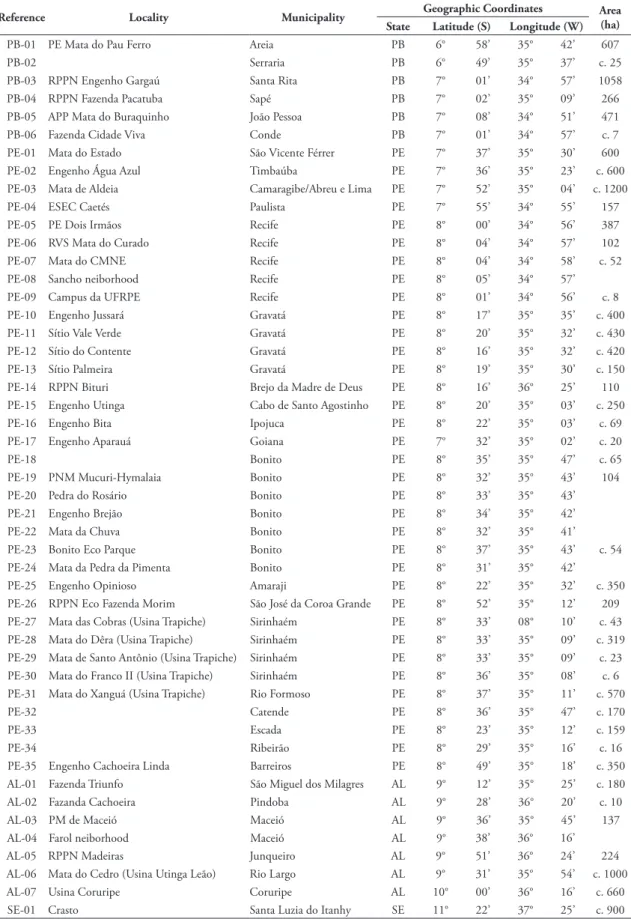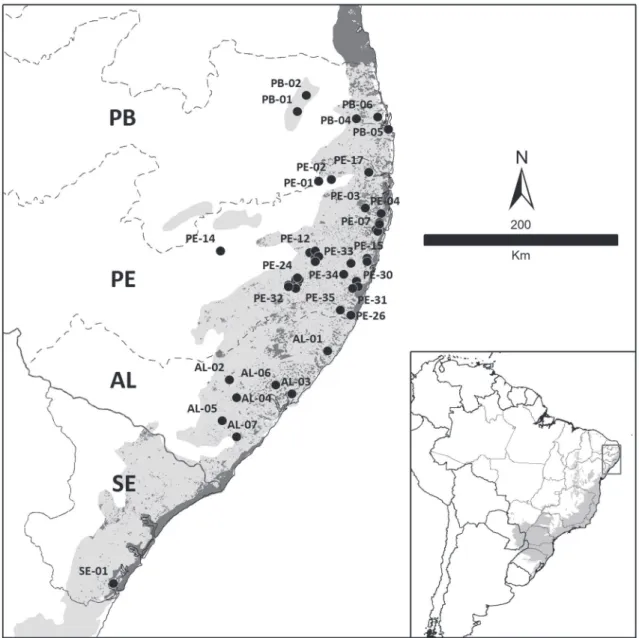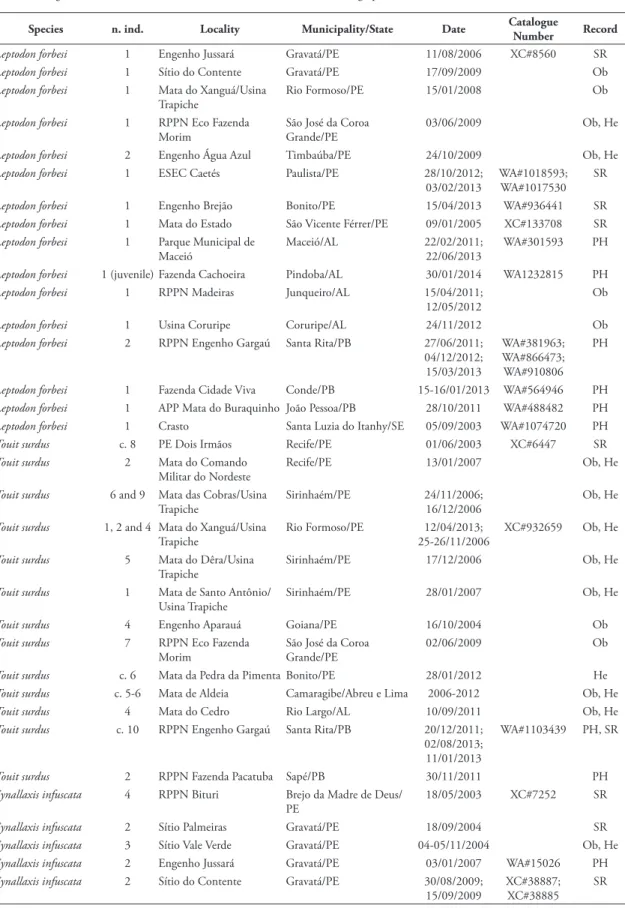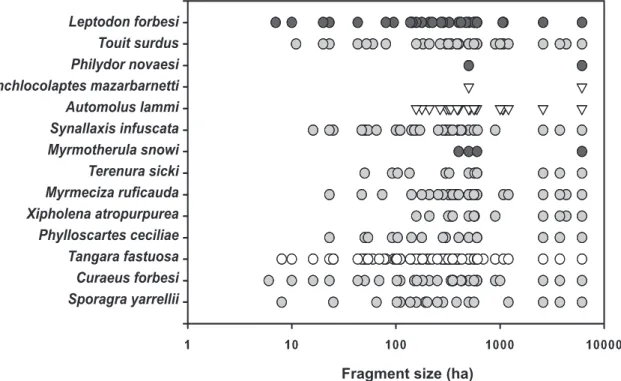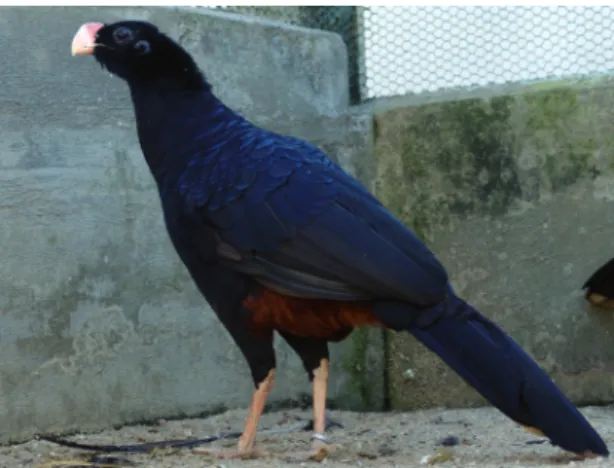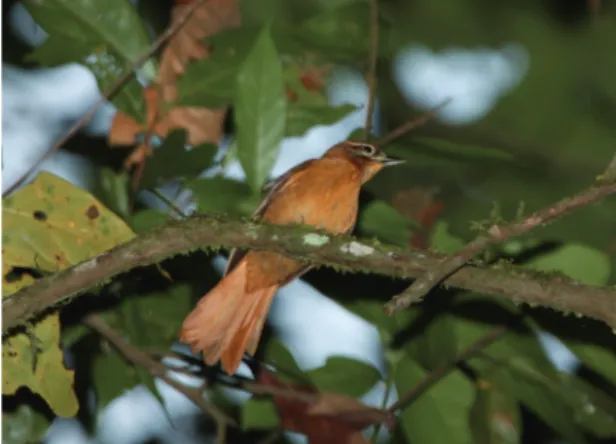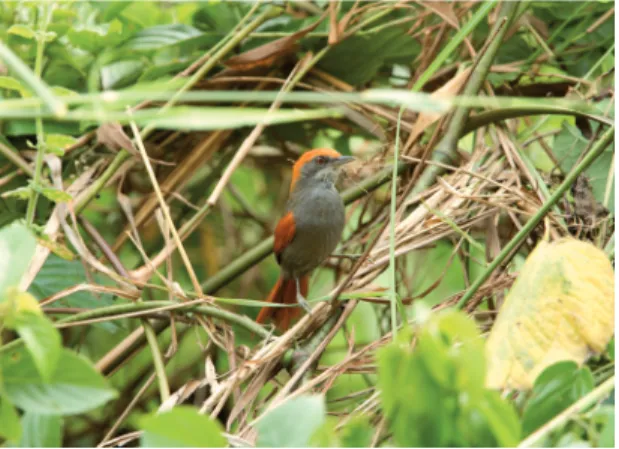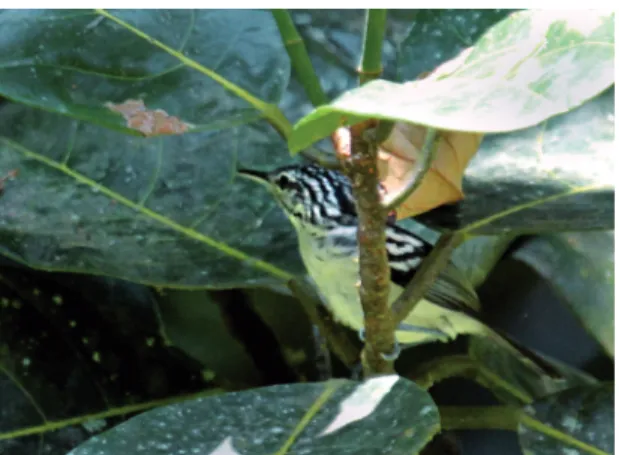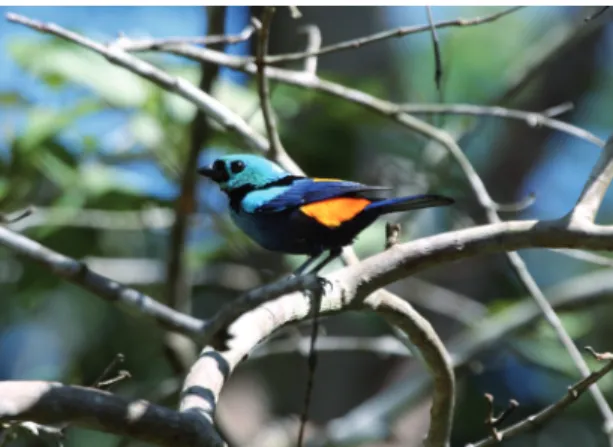S
TATUS
OF
THE
GLOBALLY
THREATENED
FOREST
BIRDS
OF
NORTHEAST
B
RAZIL
G
LAUCOA
LVESP
EREIRA1S
IDNEIDEM
ELOD
ANTAS2L
UÍSF
ÁBIOS
ILVEIRA3S
ÔNIAA
LINER
ODA4C
IROA
LBANO5F
REDERICOA
CAZS
ONNTAG6S
ERGIOL
EAL7M
AURICIOC
ABRALP
ERIQUITO4G
USTAVOB
ERNARDINOM
ALACCO8A
LEXANDERC
HARLESL
EES9ABSTRACT
The Atlantic Forest of northeast Brazil hosts a unique biota which is among the most
threat-ened in the Neotropics. Near-total conversion of forest habitat to sugar cane monocultures has
left the region’s endemic forest-dependent avifauna marooned in a few highly-fragmented and
degraded forest remnants. Here we summarise the current status of 16 globally threatened
spe-cies based on surveys conducted over the last 11 years. We found a bleak situation for most of
these species and consider that three endemics:
Glaucidium mooreorum
(Pernambuco
Pyg-my-owl),
Cichlocolaptes mazarbarnetti
(Cryptic Treehunter) and
Philydor novaesi
(Alagoas
Foliage-gleaner) are most likely globally extinct. Some positive news can, however, be reported
for both
Leptodon forbesi
(White-collared Kite) and
Synallaxis infuscata
(Pinto’s Spinetail)
http://dx.doi.org/10.1590/0031-1049.2014.54.14
1. Universidade Federal Rural de Pernambuco (UFRPE), Programa de Pós-Graduação em Etnobiologia e Conservação da Natureza. Rua Manoel de Medeiros, s/n, Dois Irmãos, CEP 52171-900, Recife, PE, Brasil and Observadores de Aves de Pernambuco (OAP). E-mail for correspondence: glaucoapereira@yahoo.com.br
2. Coordenação de Zoologia, Museu Paraense Emílio Goeldi. Caixa Postal 399, CEP 66040-170, Belém, Pará, Brasil and Observadores de Aves de Pernambuco (OAP).
3. Curador das coleções ornitológicas, Museu de Zoologia da Universidade de São Paulo, Caixa Postal 42.494, CEP 04218-970, São Paulo, SP, Brasil.
4. Observadores de Aves de Pernambuco (OAP). Rua Agamenon Magalhães, 28, QC13, Engenho Maranguape, CEP 53423-440, Paulista, PE, Brasil.
5. NE Brazil Birding. Rua das Laranjeiras, 485, Lagoa Redonda, CEP 60831-620, Fortaleza, CE, Brasil. 6. Rua David Ferreira Luna, 151, Apartamento 1002, Brisamar, CEP 58033-090, João Pessoa, PB, Brasil.
7. Organização de Preservação Ambiental (OPA). Loteamento Valparaíso, Rua 02, Quadra D, 281, CEP 57043-015, Feitosa, Maceió, AL, Brasil.
8. Associação para a Gestão Socioambiental do Triângulo Mineiro (ANGÁ), Av. Anselmo Alves dos Santos, 119, sala 04, Saraiva, CEP 38408-008, Uberlândia, MG, Brasil.
which may warrant re-evaluation of their respective red list statuses. We outline a road map to
prioritise conservation interventions in the region directed at preventing the extinction of this
suite of threatened bird species and their companion biota.
Key-Words: Fragmentation; Species-area relationship; Conservation intervention;
Pro-tected areas.
ternational IUCN Red List (IUCN, 2013), making
the PCE the Brazilian ecosystem with the highest
rela-tive number of threatened birds (Olmos, 2005) and
probably one of the most threatened in the world (see
the list of endemic and threatened species in Silveira
et al.,
2003a). Distributional data for these threatened
taxa is critical for effective conservation planning, to
revise threat assessments and more pessimistically to
document the likely imminent extinction of some of
these bird species. Here we present new records for
globally threatened species, synthesise knowledge on
their tolerance to habitat loss and fragmentation, and
assess their future conservation prospects.
METHODS
Study area and bird surveys
The PCE is divided into three geographical
sub-units: the coastal plain, the São Franciscana depression
and the Planalto da Borborema (IBGE, 1985), this
last stretching across the entire PCE over 900 m asl
(Moreira, 1977). The regional climate is hot and
hu-mid (Nimer, 1972), with the rainfall decreasing from
the coastal plain to the interior, and increasing again at
the highest altitudes (Annel, 1998
apud
Roda, 2003).
On the coast, annual rainfall varies from 1,750 to
2,000 mm, with a dry season lasting from October
to January. In the interior annual rainfall varies from
1,250 to 1,750 mm, with a longer dry season
extend-ing between October and March (Coutinho
et al.,
1998; IBGE, 1985). Broadly interpreted, the
Atlan-tic Forest in the PCE includes mangroves, restingas,
semideciduous and ombrophilous forests, and their
contact zones (IBGE, 2004; Tabarelli
et al.,
2006).
Ombrophilous forests are dominated by trees in the
families Leguminosae, Lauraceae, Sapotaceae,
Chryso-balanaceae, and Lecythidaceae (Grillo
et al.,
2006).
We compiled data from both intensive targeted
bird surveys and opportunistic observations in the
PCE over the course of the last 11 years, accumulating
data for many globally-threatened bird species. These
surveys were undertaken in Atlantic Forest fragments
of varying size, from 6 to 1,200 hectares, all with
lit-INTRODUCTION
The Atlantic Forest stretches across eastern
Brazil, eastern Paraguay and northeastern Argentina
(Rizzini, 1997). It is subdivided into regional
biogeo-graphic provinces or centres of endemism with their
own unique biotas (Silva & Casteletti, 2003; Silva
et al.,
2004). The most threatened of these endemic
areas is the Pernambuco Centre of Endemism
(hence-forth PCE) in northeastern Brazil, a strip of Atlantic
Forest north of the São Francisco River, encompassing
the states of Alagoas, Pernambuco, Paraíba and Rio
Grande do Norte (Brown, 1982; Prance, 1982).
This region has suffered from both the first
(dating back to the 16
thcentury) and the most severe
waves of forest loss observed in any Brazilian
ecore-gion. Deforestation rates accelerated during the late
1970s and early 1980s (Silveira
et al.,
2003a) when
the last remaining large tracts of lowland forest were
lost. This pulse of forest loss was driven by a Brazilian
government program (with the support of the World
Bank) called PROALCOOL which was launched in
1975 and aimed to increase ethanol production as a
substitute for gasoline, helping Brazil to reduce its
de-pendence on oil following the global petroleum crisis
of the early 1970s (Teixeira, 1986; Cavalcanti, 1992;
Silveira
et al.,
2003a; Martinelli & Filoso, 2008). This
drive for energy independence came at a cost of most
remaining forest, leaving the regional landscape
dom-inated by sugar-cane monocultures (Silveira
et al.,
2003a; Tabarelli
et al.,
2010). Regional forest cover is
now reduced to 12.1% of its original pre-Columbian
extent (Ribeiro
et al.,
2009).
The legacy of this assault on the region’s forests
is that 48% of the remaining fragments are smaller
than 10 ha and very few are larger than 1,000 ha,
moreover all are embedded in a hostile matrix of
sug-ar cane plantations (Ranta
et al.,
1998). Remaining
forest patches are threatened by on-going
degrada-tion from fire, selective-logging and firewood removal
and the large-bodied vertebrate fauna is threatened by
hunting (Silveira
et al.,
2003a).
In-TABlE 1: Localities visited in the PCE.
Reference locality Municipality Geographic Coordinates Area
(ha)
State latitude (S) longitude (W)
PB-01 PE Mata do Pau Ferro Areia PB 6° 58’ 35° 42’ 607
PB-02 Serraria PB 6° 49’ 35° 37’ c. 25
PB-03 RPPN Engenho Gargaú Santa Rita PB 7° 01’ 34° 57’ 1058 PB-04 RPPN Fazenda Pacatuba Sapé PB 7° 02’ 35° 09’ 266 PB-05 APP Mata do Buraquinho João Pessoa PB 7° 08’ 34° 51’ 471 PB-06 Fazenda Cidade Viva Conde PB 7° 01’ 34° 57’ c. 7 PE-01 Mata do Estado São Vicente Férrer PE 7° 37’ 35° 30’ 600 PE-02 Engenho Água Azul Timbaúba PE 7° 36’ 35° 23’ c. 600 PE-03 Mata de Aldeia Camaragibe/Abreu e Lima PE 7° 52’ 35° 04’ c. 1200 PE-04 ESEC Caetés Paulista PE 7° 55’ 34° 55’ 157 PE-05 PE Dois Irmãos Recife PE 8° 00’ 34° 56’ 387 PE-06 RVS Mata do Curado Recife PE 8° 04’ 34° 57’ 102 PE-07 Mata do CMNE Recife PE 8° 04’ 34° 58’ c. 52 PE-08 Sancho neiborhood Recife PE 8° 05’ 34° 57’ PE-09 Campus da UFRPE Recife PE 8° 01’ 34° 56’ c. 8 PE-10 Engenho Jussará Gravatá PE 8° 17’ 35° 35’ c. 400 PE-11 Sítio Vale Verde Gravatá PE 8° 20’ 35° 32’ c. 430 PE-12 Sítio do Contente Gravatá PE 8° 16’ 35° 32’ c. 420 PE-13 Sítio Palmeira Gravatá PE 8° 19’ 35° 30’ c. 150 PE-14 RPPN Bituri Brejo da Madre de Deus PE 8° 16’ 36° 25’ 110 PE-15 Engenho Utinga Cabo de Santo Agostinho PE 8° 20’ 35° 03’ c. 250 PE-16 Engenho Bita Ipojuca PE 8° 22’ 35° 03’ c. 69 PE-17 Engenho Aparauá Goiana PE 7° 32’ 35° 02’ c. 20
PE-18 Bonito PE 8° 35’ 35° 47’ c. 65
PE-19 PNM Mucuri-Hymalaia Bonito PE 8° 32’ 35° 43’ 104 PE-20 Pedra do Rosário Bonito PE 8° 33’ 35° 43’ PE-21 Engenho Brejão Bonito PE 8° 34’ 35° 42’ PE-22 Mata da Chuva Bonito PE 8° 32’ 35° 41’ PE-23 Bonito Eco Parque Bonito PE 8° 37’ 35° 43’ c. 54 PE-24 Mata da Pedra da Pimenta Bonito PE 8° 31’ 35° 42’ PE-25 Engenho Opinioso Amaraji PE 8° 22’ 35° 32’ c. 350 PE-26 RPPN Eco Fazenda Morim São José da Coroa Grande PE 8° 52’ 35° 12’ 209 PE-27 Mata das Cobras (Usina Trapiche) Sirinhaém PE 8° 33’ 08° 10’ c. 43 PE-28 Mata do Dêra (Usina Trapiche) Sirinhaém PE 8° 33’ 35° 09’ c. 319 PE-29 Mata de Santo Antônio (Usina Trapiche) Sirinhaém PE 8° 33’ 35° 09’ c. 23 PE-30 Mata do Franco II (Usina Trapiche) Sirinhaém PE 8° 36’ 35° 08’ c. 6 PE-31 Mata do Xanguá (Usina Trapiche) Rio Formoso PE 8° 37’ 35° 11’ c. 570
PE-32 Catende PE 8° 36’ 35° 47’ c. 170
PE-33 Escada PE 8° 23’ 35° 12’ c. 159
PE-34 Ribeirão PE 8° 29’ 35° 16’ c. 16
tle, if any, connectivity to other fragments (Table 1).
Our surveys took place in six localities in Paraíba, 35
in Pernambuco and seven in Alagoas states. An
ad-ditional site outside the PCE range (in Sergipe) was
included given records of two threatened birds widely
regarded as endemic to the PCE
sensu strictu
(Fig. 1).
Species accounts are provided for taxa currently
classified as threatened on the IUCN Red List and
restricted to the PCE in addition to two recently
de-scribed or ‘upgraded’ species and we also indicate the
current national threat status as judged by the
Brazil-ian Ministry of the Environment (Ministério do Meio
Ambiente: MMA, 2003). Scientific names of the
spe-cies follow those of the Comitê Brasileiro de Registros
Ornitológicos (CBRO, 2014). Geographic
coordi-nates of survey sites, patch area, and habitat type are
listed in Table 1. Given the importance of providing
objective documentation for rare species (see
e.g.,
Lees
et al.
2014b), we present links to digital vouchers
(sound-recordings or photographs) deposited on the
Brazilian avian photo archive
Wikiaves
(www.wiki-aves.com.br) and/or the global avian sound library
xeno-canto
(www.xenocanto.org). Recordings on both
sites are searchable by the catalogue number provided
in the species accounts.
In addition to our own fieldwork we also
com-piled presence/absence data for all threatened species
recorded in the last 11 years from 99 variable-sized
forest fragments within the PCE, published both in
the primary ornithological literature and in the ‘grey’
TABlE 2: New locality data for threatened bird species in the PCE. Locality acronyms: ESEC = Estação Ecológica; RPPN = Reserva Particular do Patrimônio Natural; PE = Parque Estadual; APP = Área de Proteção Permanente; RVS = Refúgio da Vida Silvestre; REBIO = Reserva Biológica. Record: SR = Sound-recorded; Ob = Observed; PH = Photographed; HE = Heard.
Species n. ind. locality Municipality/State Date Catalogue
Number Record
Leptodon forbesi 1 Engenho Jussará Gravatá/PE 11/08/2006 XC#8560 SR
Leptodon forbesi 1 Sítio do Contente Gravatá/PE 17/09/2009 Ob
Leptodon forbesi 1 Mata do Xanguá/Usina Trapiche
Rio Formoso/PE 15/01/2008 Ob
Leptodon forbesi 1 RPPN Eco Fazenda Morim
São José da Coroa Grande/PE
03/06/2009 Ob, He
Leptodon forbesi 2 Engenho Água Azul Timbaúba/PE 24/10/2009 Ob, He
Leptodon forbesi 1 ESEC Caetés Paulista/PE 28/10/2012; 03/02/2013
WA#1018593; WA#1017530
SR
Leptodon forbesi 1 Engenho Brejão Bonito/PE 15/04/2013 WA#936441 SR
Leptodon forbesi 1 Mata do Estado São Vicente Férrer/PE 09/01/2005 XC#133708 SR
Leptodon forbesi 1 Parque Municipal de Maceió
Maceió/AL 22/02/2011; 22/06/2013
WA#301593 PH
Leptodon forbesi 1 (juvenile) Fazenda Cachoeira Pindoba/AL 30/01/2014 WA1232815 PH
Leptodon forbesi 1 RPPN Madeiras Junqueiro/AL 15/04/2011; 12/05/2012
Ob
Leptodon forbesi 1 Usina Coruripe Coruripe/AL 24/11/2012 Ob
Leptodon forbesi 2 RPPN Engenho Gargaú Santa Rita/PB 27/06/2011; 04/12/2012; 15/03/2013
WA#381963; WA#866473; WA#910806
PH
Leptodon forbesi 1 Fazenda Cidade Viva Conde/PB 15-16/01/2013 WA#564946 PH
Leptodon forbesi 1 APP Mata do Buraquinho João Pessoa/PB 28/10/2011 WA#488482 PH
Leptodon forbesi 1 Crasto Santa Luzia do Itanhy/SE 05/09/2003 WA#1074720 PH
Touit surdus c. 8 PE Dois Irmãos Recife/PE 01/06/2003 XC#6447 SR
Touit surdus 2 Mata do Comando Militar do Nordeste
Recife/PE 13/01/2007 Ob, He
Touit surdus 6 and 9 Mata das Cobras/Usina Trapiche
Sirinhaém/PE 24/11/2006; 16/12/2006
Ob, He
Touit surdus 1, 2 and 4 Mata do Xanguá/Usina Trapiche
Rio Formoso/PE 12/04/2013; 25-26/11/2006
XC#932659 Ob, He
Touit surdus 5 Mata do Dêra/Usina Trapiche
Sirinhaém/PE 17/12/2006 Ob, He
Touit surdus 1 Mata de Santo Antônio/ Usina Trapiche
Sirinhaém/PE 28/01/2007 Ob, He
Touit surdus 4 Engenho Aparauá Goiana/PE 16/10/2004 Ob
Touit surdus 7 RPPN Eco Fazenda Morim
São José da Coroa Grande/PE
02/06/2009 Ob
Touit surdus c. 6 Mata da Pedra da Pimenta Bonito/PE 28/01/2012 He
Touit surdus c. 5-6 Mata de Aldeia Camaragibe/Abreu e Lima 2006-2012 Ob, He
Touit surdus 4 Mata do Cedro Rio Largo/AL 10/09/2011 Ob, He
Touit surdus c. 10 RPPN Engenho Gargaú Santa Rita/PB 20/12/2011; 02/08/2013; 11/01/2013
WA#1103439 PH, SR
Touit surdus 2 RPPN Fazenda Pacatuba Sapé/PB 30/11/2011 PH
Synallaxis infuscata 4 RPPN Bituri Brejo da Madre de Deus/ PE
18/05/2003 XC#7252 SR
Synallaxis infuscata 2 Sítio Palmeiras Gravatá/PE 18/09/2004 SR
Synallaxis infuscata 3 Sítio Vale Verde Gravatá/PE 04-05/11/2004 Ob, He
Synallaxis infuscata 2 Engenho Jussará Gravatá/PE 03/01/2007 WA#15026 PH
Synallaxis infuscata 2 Sítio do Contente Gravatá/PE 30/08/2009; 15/09/2009
XC#38887; XC#38885
Species n. ind. locality Municipality/State Date Catalogue
Number Record
Synallaxis infuscata c. 8 Engenho Opinioso Amaraji/PE 15-16/04/2005 XC#5630; XC#4308;
SR
Synallaxis infuscata 1 Bonito/PE 24/03/2011 SR
Synallaxis infuscata 1 Catende/PE 29/03/2011 SR
Synallaxis infuscata c 8 Mata do Xanguá/Usina Trapiche
Rio Formoso/PE 25-26/11/2006; 16/12/2006; 16/01/2007; 13/11/2010
WA#239839 PH, SR
Synallaxis infuscata 1 Ribeirão/PE 19/06/2013 PH, SR
Synallaxis infuscata 1 PE Mata do Pau Ferro Areia/PB 09/09/2011 WA#442343; WA#650002
PH
Automolus lammi 1 PE Dois Irmãos Recife/PE 03/06/2005 HE
Automolus lammi 2 Engenho Jussará Gravatá/PE 22/10/2006; 04/01/2007
Ob
Automolus lammi 3 Mata de Aldeia Camaragibe/Abreu e Lima 05/04/2007 Ob, He
Automolus lammi 2 RPPN Engenho Gargaú Santa Rita/PB 27/06/2011; 01/07/2011
WA#382246; WA#403857
PH
Automolus lammi 1 Crasto Santa Luzia do Itanhy/SE 18/03/2004 WA#90429; XC#80772
PH, SR
Myrmeciza ruficauda 1 Mata de Aldeia Camaragibe/Abreu e Lima 15/06/2009 SR
Myrmeciza ruficauda c. 9-10 Engenho Cachoeira Linda Barreiros/PE 2006-2011 Ob, He
Myrmeciza ruficauda 2? Engenho Brejão Bonito/PE 15/04/2013 HE
Myrmeciza ruficauda 2? Mata da Chuva Bonito/PE ?/11/2011 HE
Terenura sicki 2 PNM Matas do Mucuri-Himalaya
Bonito/PE 05/07/2011 Ob
Terenura sicki c. 5 Engenho Brejão Bonito/PE 15/04/2013 Ob
Xipholena atropurpurea
1 Mata do Dêra/Usina Trapiche
Sirinhaém/PE 17/11/2006 XC #8950 SR
Xipholena atropurpurea
2 Mata do Xanguá/Usina Trapiche
Rio Formoso/PE 17/11/2006 Ob
Xipholena atropurpurea
2 and 3 Engenho Cachoeira Linda Barreiros/PE 12/03/2006; 29/01/2009
Ob, He
Xipholena atropurpurea
2 RPPN Eco Fazenda Morim
São José da Coroa Grande/PE
02/06/2009 Ob, He
Phylloscartes ceciliae 4 Engenho Jussará Gravatá/PE 22/10/2006 XC#7916 SR
Phylloscartes ceciliae 2 PNM Matas do Mucuri-Himalaya
Bonito/PE 05/07/2011 Ob, He
Phylloscartes ceciliae 2 Engenho Brejão Bonito/PE 14/04/2013 XC#7916 SR
Phylloscartes ceciliae 2 Pedra do Rosário Bonito/PE 13/04/2013 Ob, He
Tangara fastuosa 3 RVS Mata do Curado Recife/PE 15/04/2003; 30/11/2003
Ob
Tangara fastuosa 4 RPPN Bituri Brejo da Madre de Deus/ PE
18/05/2003 Ob
Tangara fastuosa 4 Bonito Ecoparque Bonito/PE 04/04/2004 Ob
Tangara fastuosa 6 Sítio Vale Verde Gravatá/PE 05/11/2004 Ob
Tangara fastuosa 3 Engenho Jussará Gravatá/PE 24/04/2005 Ob
Tangara fastuosa 7 Engenho Opinioso Amaraji/PE 15/04/2005 Ob
Tangara fastuosa 4 Mata das Cobras/Usina Trapiche
Sirinhaém/PE 25/11/2006 Ob
Tangara fastuosa 3 and 5 Mata do Xanguá/Usina Trapiche
Rio Formoso/PE 26/11/2006; 16/12/2006
XC#8945 SR
Tangara fastuosa 2 and 6 Mata do Dêra/Usina Trapiche
Sirinhaém/PE 17/12/2006; 27/01/2007
Ob
Tangara fastuosa 6 RPPN Eco Fazenda Morim
São José da Coroa Grande/PE
RESUlTS
Our surveys amassed 97 new records of 11
threatened bird species (see Table 2). Richness of
threatened species per fragment increased over the
range of observed fragment sizes in the PCE (mean:
3.22 threatened species per fragment, SD: 2.72 range
1-14), generating a significant semi-log species-area
relationship (r
2= 0.236, P < 0.001, N = 99, Fig. 2).
Threatened species varied in their responses to habitat
fragmentation even among respective IUCN threat
classes (Fig. 3) in a highly species-specific manner.
literature –
e.g.,
unpublished consultancy reports (for
additional data sources see Appendix). With this
in-formation we created a species-by-site matrix with
binary presence/absence data. Using this matrix we
assessed the species-area relationship between forest
fragment area (log
10ha) and number of threatened
bird species, performing a linear regression model
considering all 99 forest fragments for which we
could find bird data. The R
2value that we report is
the adjusted R
2. We also constructed a horizontal
point plot illustrating species presence/absence in all
forest fragments.
Species n. ind. locality Municipality/State Date Catalogue
Number Record
Tangara fastuosa 3 Engenho Utinga Cabo de Santo Agostinho/ PE
03/03/2012 Ob, He
Tangara fastuosa 2 Engenho Bita Ipojuca/PE 04/03/2012 Ob, He
Tangara fastuosa 2 Ribeirão/PE 19/06/2013 Ob
Tangara fastuosa 4 Serraria/PB 31/12/2006 XC#9411 SR
Tangara fastuosa 1 Fazenda Cachoeira Pindoba/AL 02/02/2011 WA#301686 PH
Tangara fastuosa 1 Fazenda Triunfo São Miguel dos Milagres/ AL
17/11/2011 WA#281101 PH
Tangara fastuosa 2 RPPN Madeiras Junqueiro/AL 14/06/2012 Ob
Tangara fastuosa 1 Farol neighboorhood Maceió/AL 04/01/2013 Ob
Curaeus forbesi 7 Sítio Palmeiras Gravatá/PE 18/09/2004 XC#7272 SR
Curaeus forbesi 3 Sítio Vale Verde Gravatá/PE 05/11/2004 Ob, He
Curaeus forbesi c. 15 Engenho Opinioso Amaraji/PE 15/04/2005 Ob, He
Curaeus forbesi c. 30 RPPN Eco Fazenda Morim
São José da Coroa Grande/PE
02-03/06/2009 SR
Curaeus forbesi c. 20 Engenho Utinga Cabo de Santo Agostinho/ PE
03/03/2012 Ob, He
Curaeus forbesi c. 15 to 20 Engenho Bita Ipojuca/PE 04/03/2012 Ob, He
Curaeus forbesi 5 to 20 Engenho Cachoeira Linda Barreiros/PE 2003-2011 Ob, He
Curaeus forbesi c. 7 to 11 Mata das Cobras/Usina Trapiche
Sirinhaém/PE 24-25/11/2006; 16 and 28/01/2007
XC#10211 SR
Curaeus forbesi c. 15 Mata do Xanguá/Usina Trapiche
Rio Formoso/PE 26/11/2006; 16/12/2006
XC#8944 SR
Curaeus forbesi 6 Mata de Santo Antônio/ Usina Trapiche
Sirinhaém/PE 27-28/01/2007 Ob, He
Curaeus forbesi c. 9 or 11 Mata do Franco II/Usina Trapiche
Sirinhaém/PE 25/02/2007 Ob, He
Curaeus forbesi 6 Escada/PE 31/03/2011; 01/04/2011
PH
Curaeus forbesi 1 Ribeirão/PE 18/06/2013 PH
Sporagra yarellii 2 RVS Mata do Curado Recife/PE 30/11/2003 Ob, He
Sporagra yarellii 6 and 8 Sancho neighboorhood Recife/PE 22/04/2004; 15/05/2004
Ob, He
Sporagra yarellii 2 Campus da UFRPE Recife/PE 20/09/2011 Ob, He
Sporagra yarellii 2 RPPN Bituri Brejo da Madre de Deus/ PE
18/05/2003 Ob, He
Sporagra yarellii c. 4 Mata de Aldeia Camaragibe/Abreu e Lima 12/03/2005 Ob, He
Sporagra yarellii 1 Engenho Utinga Cabo de Santo Agostinho/ PE
03/03/2012 Ob, He
FIGURE 3: Patch occupancy for 13 threatened species of the PCE between 2003-2014, dark grey circles denote critically endangered (CR) species, light grey circles endangered (EN) species and white circles vulnerable (VU) species. The white triangles are used for two species –
Cichlocolaptes mazarbanetti and Automolus lammi which have yet to be evaluated by the IUCN.
Threatened species richness
Forest fragment size (ha)
Both the well-inventoried 6,116 ha Estação Ecológica
de Murici (ESEC Murici) and the 500 ha Mata do
Quengo (RPPN Frei Caneca) held all the threatened
species at least up until 2007 (see accounts for
Phily-dor novaesi
and
Myrmotherula snowi
) but extinctions
of these species have been subsequently documented
at these sites. Some globally threatened species were
not encountered despite our searches, and these
nega-tive results are also presented to highlight the critical
situation of some threatened birds in the PCE.
Species accounts
Pauxi mitu
(linnaeus, 1766), Alagoas Curassow
(IUCN and MMA: EW; Fig. 4)
The last observations of this species from the
wild were made in lowland forest fragments at
Ro-teiro, Barra de São Miguel, Pilar, and Marechal
De-odoro in the mid 1980s (Teixeira, 1986; Silveira
et al.,
2004). There have been no subsequent sightings by
ornithologists in the region and semi-structured
in-terviews with local people living around suitable forest
fragments failed to indicate any recent sightings
(Sil-veira
et al.,
2004, GAP unpublished data). However,
prior to this species’ extinction in the wild, a few
indi-viduals were captured and a captive breeding program
was launched. This program is now composed of both
hybrids (with Razor-billed Currasow
Pauxi tuberosa
)
and pure-bred individuals, and is currently run by two
aviculturists in Minas Gerais, Brazil (see Silveira
et al.,
2004). This captive population, now numbering over
100 pure-bred individuals, is subject to genetic
man-agement (Francisco
et al.,
in prep.) with a
reintroduc-tion program scheduled to start in 2015 in Alagoas.
Leptodon forbesi
(Swann, 1922),
White‑collared Kite (IUCN: CR)
Considered one of the world’s most threatened
raptors, this species was recently “rediscovered” (Pereira
et al.,
2006; Dénes
et al.,
2011), when recorded from
12 localities in the states of Alagoas and Pernambuco
(Seipke
et al.,
2011). This species was considered a
PCE endemic, but there is now a single recent record
south of the São Francisco river in Sergipe outside of
the PCE which may be a vagrant individual – perhaps
unsurprising as a river is unlikely to form a major
bar-rier for a large soaring forest raptor. We recorded this
species from another 16 sites in Pernambuco, Alagoas
and Paraíba states (Table 2). This series of new records
(including the first for the state of Paraíba) suggests
that this species is more widespread in the PCE than
formerly thought. The persistence of some
individu-als in small and degraded forest fragments (and likely
an ability to move between different forest patches)
coupled with an apparent absence of hunting
pres-sure, suggest a degree of resilience to land-use change
in the region, although quantitative studies should be
undertaken to assess this assumption. Nevertheless, we
suggest that this species also ought to be the target of
a captive breeding program given the relative ease at
which raptors can be maintained and bred in captivity.
Touit surdus
(Kuhl, 1820),
Golden‑tailed Parrotlet (IUCN: VU)
Despite its relatively ample distribution in the
Atlantic Forest – stretching from Paraíba to São Paulo
(Collar, 1997; Forshaw, 2010), this species is only
known from only 12 localities in the PCE (Roda,
2003) with Silveira
et al.
(2003a) finding this parrotlet
in 5 of 15 surveyed forest fragments (Fig. 3). Our
field-work produced additional records from 13 localities in
Pernambuco, Paraíba and Alagoas (Table 2). As with
the preceding species, this parrotlet may be
preadapt-ed to life in fragmentpreadapt-ed landscapes as these and other
psittacids have to track spatio-temporally variable fruit
resources (
e.g.,
Lees & Peres, 2009). Parrotlets in the
genus
Touit
have very poor survivorship in captivity
and are thus not highly sought after by bird traffickers
(Collar, 2000). A pair was observed attending a nest
in an arboreal termitarium in the RPPN Fazenda
Pa-catuba, municipality of Sapé, Paraíba. The preference
for nesting in arboreal termitaria frees members of this
genus from dependence on tree hollows, required by
many parrot species.These may be a
population-lim-iting factor in degraded and regenerating forests with
few large old trees (
e.g.,
Cockle
et al.,
2010).
FIGURE 4:Pauxi mitu (Linnaeus, 1766), Alagoas Curassow,
Glaucidium mooreorum
Silva, Coelho & Gonzaga, 2002,
Pernambuco Pygmy‑owl (IUCN: CR)
Documented records of this enigmatic species
include just the type series of two individuals collected
in November 1980 and a single sound-recording
ob-tained in October 1990 from the Reserva Biológica
(REBIO) de Saltinho, Pernambuco. Since its
descrip-tion, the species has been extensively sought-after by
many different fieldworkers in forest fragments across
the PCE using playback of the single vocal sample
available (see Roda & Pereira, 2006; Roda
et al.,
2011).
These searches have resulted in just one subsequent
undocumented sight record of a single bird observed at
Usina Trapiche in November 2001 (Silva
et al.,
2002).
Our own playbacks elicited a mobbing response in
small passerines (
e.g.,
Red-headed Manakin
Cerato-pipra rubrocapilla,
Olivaceous Woodcreeper
Sittasomus
griseicapillus,
Variable Oriole
Icterus pyrrhopterus
) at
Engenho Cachoeira Linda, Mata do Roncadorzinho,
and other fragments
e.g.,
the Usina Trapiche (Mata
do Dêra, Mata do Sá and Engenho Jaguaré) which we
may interpret as evidence of the historic occurrence
of
G. mooreorum
in these localities. Given the
ab-sence of records for a minimum period of 12 years, we
consider that this species may be potentially extinct.
Galileu Coelho (
pers. comm.
) regularly heard one or
more individuals of this species singing near the main
house of the Saltinho research station until the start of
the 1990’s. Pygmy-owls belonging to the
Glaucidium
minutissimum
species complex (which also includes
G. hardyi
) (Marks
et al.,
1999) occur at low
densi-ties in well-preserved forest physiognomies, so there
is now very little suitable habitat left for this species
in the PCE. However, there are several precedents for
the rediscovery of cryptic night birds (
e.g.,
Halleux &
Goodman, 1994; King & Rasmussen, 1998) and we
encourage observers to keep looking, just in case.
Philydor novaesi
Teixeira & Gonzaga, 1983,
Alagoas Foliage‑gleaner (IUCN and MMA: CR)
Discovered at Murici, Alagoas in 1979 (Teixeira
& Gonzaga, 1983), this species has only ever been
found at this type locality and the RPPN Frei
Can-eca, Pernambuco (Roda, 2008; Roda
et al.,
2011,
Fig. 5). This is one of the most highly sought-after
species (by both visiting birders and professional
ornithologists alike), and ourselves and others have
searched extensively for this species in forest
frag-ments across the PCE (even in forest patches
out-side of the ‘known’altitudinal range) but with no
success. Playback of vocalisations of the Alagoas
Foliage-gleaner – a nuclear species in mixed-species
flocks (acting to aggregate, and orientate other flock
members), attracted facultative flock-following
het-erospecifics (Mazar-Barnett
et al.,
2005; Roda, 2008;
Roda
et al.,
2011), such as the Long-billed Gnatwren
Ramphocaenus melanurus
(at Murici and Bonito),
Rufous-winged Antwren
Herpsilochmus
rufimargin-atus
and White-flanked Antwren
Myrmotherula
axil-laris
(at Mata do Estado). We interpret the reaction
of these flock-following species as expressing interest
in joining a flock and evidence for the historic
oc-currence of this species at Mata do Estado, Engenho
Água Azul, Bonito and Gravatá. This species was last
recorded from Murici in 2007 (sound-recording in
Minns
et al.,
2009 and image here: http://ibc.lynxeds.
com/photo/alagoas-foliage-gleaner-philydor-novaesi/
perched-adult) and last recorded from Frei Caneca
in September 2011 (CA, video-recording) despite
subsequent intensive searches at both these localities.
Along with Pernambuco Pygmy-owl, we consider the
Alagoas Foliage-gleaner likely extinct following
for-est loss, fragmentation and degradation. The
disap-pearance of these species represent the first evidence
for extinctions of endemic Brazilian birds in modern
times (see Lees
et al.,
2014a).
Cichlocolaptes mazarbarnetti
Barnett & Buzzetti, 2014,
Cryptic Treehunter (Not Evaluated)
This recently-described taxon (Mazar-Barnett &
Buzzetti, 2014), was formerly confused with the
pre-ceding species with which it is cryptically similar but
differs subtly in morphology, plumage, behaviour and
vocalizations (see also Claramunt, 2014). Like
Phily-dor novaesi
it is only known from Murici and RPPN
FIGURE 5:Philydor novaesi Teixeira & Gonzaga, 1983, Alagoas
Frei Caneca and was apparently a specialist in
forag-ing in arboreal bromeliads. Mazar-Barnett & Buzzetti
(2014) suggest that it should be listed as Critically
En-dangered both nationally and internationally.
Realis-tically however this species is also likely extinct, there
have been no records from other sites in the region
and the last records from Frei Caneca were obtained
in February 2005 (D. Buzzetti: XC#180936) and the
last records from Murici was in April 2007 (D.
Buz-zetti: XC#180893). The disappearance of these two
Furnarids and the
Glaucidium
pygmy-owl represent
the first evidence for extinctions of endemic Brazilian
birds in modern times.
Synallaxis infuscata
Pinto, 1950,
Pinto’s Spinetail (IUCN and MMA: EN)
This PCE endemic is inferred to be in decline
due to forest loss and fragmentation (Remsen, 2003)
although we found it to be locally common,
occupy-ing edge habitats and exhibitoccupy-ing a greater tolerance
to habitat fragmentation than other endemic birds in
the PCE, potentially warranting a re-evaluation of its
status (Fig. 3). Roda
et al.
(2011) were able to compile
records in 53 localities in the PCE. We recorded this
species from nine sites in Pernambuco and Paraíba
states (Table 2, Fig. 6).
Automolus lammi
Zimmer, 1947,
Pernambuco Foliage‑gleaner (Not Evaluated)
Zimmer (2008) advocated splitting this taxon
from its putative sister-species, the White-eyed
Foli-age-gleaner (
Automolus leucophthalmus
) a change
sub-sequently adopted by the South American
Classifica-tion Committee (Remsen
et al.,
2013) which means a
formal conservation assessment by the IUCN is due.
We consider this species to be globally threatened
giv-en that it is only known from 16 localities in
Pernam-buco, Paraíba and Alagoas (Roda, 2003; Silveira
et al.,
2003a; Farias
et al.,
2007) and we present records from
five new sites (Table 2). This species was also found
south of the São Francisco river, in Sergipe (beyond the
PCE as usually delimited) at the Mata do Crasto, in
the municipality of Santa Luzia do Itanhy by A.
Gros-set & J. Minns. It is hoped that the belated recognition
of species status for this distinctive taxon may afford it
a higher conservation profile (
e.g.,
Mace, 2004).
Myrmotherula snowi
Teixeira & Gonzaga, 1985,
Alagoas Antwren (IUCN and MMA: CR)
This species is known from just four disjunct
lo-calities: ESEC Murici (Alagoas), RPPN Frei Caneca,
Mata do Estado and Engenho Jussará (Pernambuco)
(Mazar-Barnett
et al.,
2005; Roda
et al.,
2011). There
have been no recent records from RPPN Frei Caneca,
where the last report concerns a single female
photo-graphed in 2007 (WA#92572; 13/12/2007). Despite
extensive searching using playback (
e.g.,
at
Engen-ho Jussará, Bonito, Gravatá, Maraial and Brejo dos
Cavalos), we were unable to find any additional sites
for this species. This species requires urgent
conserva-tion intervenconserva-tion to prevent its imminent extincconserva-tion;
less than 30 individuals are thought to survive and the
species shares life history traits (such as area
sensitiv-ity and obligatory flock-following behaviour) with the
Alagoas Foliage-gleaner (see Lees
et al.,
2014a).
Myrmoderus ruficaudus soror
(Pinto, 1940),
Scalloped Antbird (IUCN and MMA: EN)
This species is represented in the PCE by the
endemic subspecies
M. r. soror,
which is confined to
humid forests in the states of Paraíba, Pernambuco
and Alagoas (Zimmer & Isler, 2003; Grantsau, 2010).
This taxon is known in the PCE from 29 localities
(Farias
et al.,
2002; Roda, 2003; Silveira
et al.,
2003a;
Farias
et al.,
2007, 2010) and currently persists in
for-est fragments of varying sizes and in varying states of
degradation. We recorded this species from an
addi-tional four sites in Pernambuco (Table 2).
Terenura sicki
Teixeira & Gonzaga, 1983,
Orange‑bellied Antwren (IUCN and MMA: EN)
Roda
et al.
(2011) reported this PCE endemic in
14 forest fragments in upland forest (between 300 and
700 m asl) in the states of Pernambuco and Alagoas.
Albano (2009) also reported this species in lowland
FIGURE 6:Synallaxis infuscata Pinto, 1950, Pinto’s Spinetail,
forest (c. 80 m asl) at Usina Trapiche. We add two
new localities in Pernambuco (Table 2, Fig. 7). This
species is typically seen accompanying mixed-species
flocks: at the Parque Natural Municipal
Mucuri-Hi-malaya it was observed foraging with
Veniliornis
sp.,
Sittasomus griseicapillus, Herpsilochmus atricapillus,
Phylloscartes ceciliae, Basileuterus culicivorus
and
Lanio
cristatus,
and at the Engenho Brejão was observed in a
mixed species flock including
Myrmotherula axillaris,
Herpsilochmus atricapillus
and
Phylloscartes ceciliae.
This species is still recorded with some frequency at
the Mata do Estado and Engenho Água Azul (GAP),
and six territories were located at the 630 ha RPPN
Frei Caneca in November 2012 (ACL: WA#814109,
XC#113530; November/2012). It has apparently
declined to a handful of pairs (perhaps now a single
pair) at the ESEC Murici, Alagoas (Albano 2009,
A. Whittaker
pers. comm.
). The causes of this
near-extinction at the latter site are unknown, but given
that the ESEC Murici is the largest remaining forest
patchin the PCE this is a very worrying trend, and we
consider that this species now qualifies for Critically
Endangered status based on a total population now
estimated at fewer than 250 mature individuals in a
few disparate forest fragments.
Xipholena atropurpurea
(Wied, 1820),
White‑winged Cotinga (IUCN and MMA: EN)
Restricted to primary lowland and adjacent
foothill Atlantic forest (up to 900 m asl), between
Paraíba and Rio de Janeiro (Snow, 2004), it has been
reported from 13 protected areas (BirdLife
Interna-tional, 2013). This species has been recorded from 25
localities in the PCE between 1961 and 2003 (Roda,
2003). Our fieldwork produced records from an
ad-ditional four sites in Pernambuco (Table 2, Fig. 8).
Phylloscartes ceciliae
Teixeira, 1987,
Alagoas Tyrannulet (IUCN and MMA: EN)
This PCE endemic is known from 17 localities
in the states of Pernambuco and Alagoas (Roda
et al.,
2011) and was found in just one of 15 fragments
in-ventoried by Silveira
et al.
(2003a). We found this
species in another four sites in Pernambuco (Table 2,
Fig. 9). Although still highly imperilled, this species’
conservation prospects are slightly brighter than those
of the other four ‘Murici endemics’ –
Philydor novaesi,
Cichlocolaptes mazarbarnetti, Myrmotherula snowi
and
Terenura sicki,
occurring in more forest patches albeit
always at low densities (Fig. 3).
Tangara fastuosa
(lesson, 1831),
Seven‑colored Tanager (IUCN and MMA: VU)
Silveira
et al.
(2003b) summarized the
conserva-tion status and distribuconserva-tion of this species. Here, we
report 18 additional records across three states
(Ta-FIGURE 8:Xipholena atropurpurea (Wied, 1820), White-winged
Cotinga, Porto Seguro, BA, November 2008 (Ciro Albano).
FIGURE 9:Phylloscartes ceciliae Teixeira, 1987, Alagoas
Tyrannu-let, Frei Caneca, PE, December 2007 (Ciro Albano).
FIGURE 7:Terenura sicki Teixeira & Gonzaga, 1983,
ble 2, Fig. 10). Of the endemic and threatened birds
of the PCE, this tanager is among the most tolerant
to habitat disturbance, occupying forest edges and
or-chards where breeding behaviour has been observed
(Fig. 3, Silveira
et al.,
2003b). Capture for the illegal
bird trade remains a threat, with individuals traded in
illegal street markets around Recife, Pernambuco
be-tween June 2000 and June 2005, and bebe-tween August
2010 and April 2011 (Pereira & Brito, 2005;
Reg-ueira & Bernard, 2012).
Curaeus forbesi
(Sclater, 1886),
Forbes Blackbird (IUCN and MMA: EN)
This cryptic and thus often overlooked species
has two disjunct populations, one found in the PCE
and the other in the state of Minas Gerais, south-east
Brazil (Jaramillo & Burke, 1999; Fraga, 2011;
Mazzo-ni
et al.,
2012). Here, we report records from a further
13 sites in Pernambuco (Table 2, Fig. 11). The
obser-vation in Escada, Pernambuco involved a flock
forag-ing in association with
Molothrus bonariensis.
Nests of
Curaeus forbesi
are parasitised by
Molothrus bonariensis
which may represent cause declines in anthropogenic
landscapes with elevated cowbird densities (Jaramillo
& Burke, 1999; Fraga, 2011) but this behaviour has
yet to be recorded in the PCE. The pre-Columbian
habitat of Forbe’s Blackird in PCE is not known. Most
of our records came from forest edges associated with
sugar cane plantations, with many nests were found
in mango trees, near houses. Autecological studies are
needed to understand the ecology of this species in
anthropogenic landscapes.
Sporagra yarrellii
(Audubon, 1839),
Yellow‑faced Siskin (IUCN and MMA: EN)
Formerly widespread in north-eastern
Bra-zil, now all populations are very reduced and
frag-mented following decades of intense illegal trapping
(Fernandes-Ferreira
et al.,
2012). Here, we found this
species in seven new sites in Pernambuco (Table 2).
This species is still often encountered for sale in some
places in north-east Brazil.
DISCUSSION
Our surveys produced many additional records
of globally threatened bird species. We reveal that
the conservation situation for some poorly known
species such as
Leptodon forbesi
and
Synallaxis
in-fuscata
is more positive than previously thought,
given their apparent higher tolerance to habitat loss
and disturbance (Fig. 3). However, the situation for
most threatened species is very bleak; for example,
we failed to find new records or localities for
Phily-dor novaesi, Cichlocolaptes mazarbarnetti
and
Glau-cidium mooreorum,
which may be globally extinct.
Many other species such as the Alagoas Antwren
Myrmotherula snowi
are in precipitous decline and
their continued survival is dependent on
immedi-ate conservation intervention, if is not already too
late. Fragment size (Fig. 2) was a strong predictor
of threatened species richness in forest fragments
of the PCE (even considering variable survey effort
between fragments), reinforcing the need to protect
all large forest remnants. This species-area
relation-ship was likely mediated by significant unmeasured
variation in habitat quality, with logged, burned and
secondary forest patches likely harbouring fewer
threatened species (
e.g.,
Moura
et al.,
2013).
How-ever, it is also likely that variation in occupancy in
some of the larger forest patches with low threatened
FIGURE 10:Tangara fastuosa (Lesson, 1831), Seven-colored
Tana-ger, Tamandaré, PE, March 2008 (Ciro Albano).
FIGURE 11:Curaeus forbesi (Sclater, 1886), Forbes Blackbird,
species richness may reflect Pre-Columbian
differ-ences in distribution patterns; for which several of
the patches in the north of the region may lie
out-side of their respective bioclimatic distributional
envelopes.
Declines and local extinctions of many guilds
(Silveira
et al.,
2003a) even in protected areas (
e.g.,
ESEC Murici) indicate that these remaining forest
fragments may now be suboptimal for these species
following changes to the biophysical characteristics
of the fragments themselves. Small forest patches
are especially vulnerable to fire, especially after
selec-tive logging events and this sensitivity is exacerbated
by climatic edge effects such as exposure to drying
winds, which may result in tree and bromeliad
mor-tality (Siqueira-Filho & Tabarelli, 2006; Loarie
et al.,
2011).
Proposed conservation actions
1)
Consolidate existing fragments into larger
blocks
The largest remaining forest patches as ESEC
Murici are likely too small to hold viable populations
of many species in the long-term, and even fragments
as large as 10,000 ha are expected to owe extinction
debts in the long-term (
e.g.,
Ferraz
et al.,
2003; Lees
& Peres, 2008b). Land purchases for afforestation
with native tree communities (by governments or
major NGOs) should be directed at areas buffering
existing large fragments, perhaps within the remit of
the Project for the Conservation and Sustainable Use
of Brazilian Biological Diversity (PROBIO, see
Taba-relli
et al.,
2005). The resultant secondary forests will
dampen edge effects on existing primary forest
rem-nants and eventually facilitate inter-patch movements
for species (such as small insectivorous passerines)
be-haviourally reticent or physically incapable of crossing
extensive sugar cane plantations (Moore
et al.,
2008;
Lees & Peres 2009).
2)
Conferral of legal protection on existing large
unprotected forest fragments
Many of the largest fragments in the region (
e.g.,
around Bonito, Pernambuco) have no legal protection
and efforts should be maintained to at least achieve
private legal reserve (RPPN: Reserva Particulare do
Patrimônio Natural) status for these areas.
Landown-er benefits could also include additional income from
responsible ecotourism (Şekercioğlu, 2002) or
partici-pation in REDD+ carbon-trading schemes
prioritis-ing biodiversity (Gardner
et al.,
2011).
3)
Ensuring private landholder compliance with
the Brazilian Forest Code
Fulfilment of existing
Brazilian Forest Code
re-quirements, which will require effective law
enforce-ment, is needed to ensure that streams are buffered
by the requisite minimum amount of riparian forest
(APPs) and that existing legal reserve (RL)
require-ments are met. This would increase the size of and
connectivity between existing forest patches and
fa-cilitate rescue effects in small patches (Alger & Lima,
2003; Lees & Peres, 2008a).
4)
Consider captive breeding programs for criti‑
cally endangered species
For species such as
Myrmotherula snowi,
extreme
ex-situ
conservation measures such as captive
breed-ing may have to be considered (see
e.g.,
Groombridge
et al.,
2004; Lees
et al.,
2014a). Existing populations
may become extinct with one or two decades without
intervention and are unlikely to persist long-enough
to benefit from the effects of any (hypothetical)
refor-estation plans. However, there are few precedents for
the animal husbandry and captive breeding of
subos-cine passerines (although see Touchton
et al.,
2014),
so appropriate ‘practice’ species (
e.g., Myrmotherula
axillaris
as a surrogate for
M. snowi
) should be selected
first to assess the viability of such an approach before
the lives of individuals of the rarer species are risked.
5)
Survey any remaining un‑surveyed forest patches
and consider the merit of translocation of ‘strand‑
ed’ individuals of rare species to larger patches
Not all patches within the PCE have been
sur-veyed, and their remains the chance that
individu-als of species of high conservation priority may still
be found in relatively small forest patches for which
long term population survival is inviable. If this is the
case then translocation of individuals to larger forest
patches may be desirable to maintain genetic diversity
of such populations (
e.g.,
VanderWerf
et al.,
2006).
CONClUSION
Without significant, government and NGO
action, we anticipate imminent extinctions of more
threatened endemic birds from the PCE and the
reduc-tion of the regional forest avifaunal poor to a handful of
disturbance and fragmentation-tolerant species. These
extinctions will also likely include a number of PCE
endemic subspecies, many of which may be the
sub-ject of future taxonomic upgrades
e.g., Xiphorhynchus
(Orgs.). Fragmentação de ecossistemas: causas, efeitos sobre a biodiversidade e recomendações de políticas públicas. Brasília, Ministério do Meio Ambiente. p. 390-420.
BirdLife International. 2013. Species factsheet: Xipholena atropurpurea. Available at: http: <www.birdlife.org>. Access in: 13 November 2013.
Brown, K.S. 1982. Historical and ecological factors in the biogeography of aposematic Neotropical butterflies. American Zoologist, 22: 453-471.
Cavalcanti, G.A. 1992. A dinâmica econômica do PROÁLCOOL: acumulação e crise, 1975-1989. Revista Brasileira de Energia, 2: 1-9.
CBRO – Comitê Brasileiro de Registros Ornitológicos. 2011. Listas das Aves do Brasil. 10th ed. Available at: <www.
cbro.org.br>. Accessed in: 13 November 2013.
CBRO – Comitê Brasileiro de Registros Ornitológicos. 2014. Listas das Aves do Brasil. 11th ed. Available at: <www.
cbro.org.br>. Accessed in: 13 November 2013.
Claramunt, S. 2014. Morphometric insights into the existence of a new species of Cichlocolaptes in northeastern Brazil. Revista Brasileira de Ornitologia, 22: 95-101.
Cockle, K.L.; Martin, K. & Drever, M.C. 2010. Supply of tree-holes limits nest density of cavity nesting birds in primary and logged subtropical Atlantic forest. Biological Conservation, 143: 2851-2857.
Collar, N.J. 1997. Family Psittacidae (Parrots). In: del Hoyo, J.; Elliott, A. & Sargatal, J. (Eds.). Handbook of the Birds of the World. Volume 4. Sandgrouse to Cuckoos. Barcelona, Lynx Edicions, p. 280-478.
Collar, N.J. 2000. Globally threatened parrots: criteria, characteristics and cures. International Zoo Yearbook, 37: 21-35.
Coutinho, R.Q.; Lima-Filho, M.F.; Souza-Neto, J.B. & Silva, E.P. 1998. Características climáticas, geológicas, geomorfológicas e geotécnicas da reserva Ecológica de Dois Irmãos. In: Machado, I.C.; Lopes, A.V. & Porto, K.C. (Eds.).
Reserva Ecológica de Dois Irmãos: estudos em um remanescente de mata Atlântica em área urbana (Recife – Pernambuco – Brasil).
Recife, Secretaria de Ciência, Tecnologia e Meio Ambiente (SECTMA), Editora Universitária. p. 241-250.
Dénes, F.V.; Silveira, L.F.; Seipke, S.; Thorstrom, R.; Clark, W.S. & Thiollay, J.M. 2011. The White-collared Kite (Leptodon forbesi Swann, 1922) and a Review of the Taxonomy of the Grey-headed Kite (Leptodon cayanensis Latham, 1790).
The Wilson Journal of Ornithology, 123: 323-331.
Farias, G.B.: Alves, A.G.C. & Lins-e-Silva, A.C.B. 2007. Riqueza de aves em cinco fragmentos de Floresta Atlântica na Zona da Mata Norte de Pernambuco, Brasil. Biotemas, 20: 111-122. Farias, G.B.; Brito, M.T. & Pacheco, G.L. 2002. Registros ornitológicos de Pernambuco. Recife, Observadores de Aves de Pernambuco.
Farias, G.B.; Uejima, A.M.K. & Pereira, G.A. 2010. Aves endêmicas e ameaçadas de extinção em fragmento de Mata Atlântica, Município de Pombos, Pernambuco. Atualidades Ornitolológicas, 156: 20-22.
Fernandes-Ferreira, H.; Mendonça, S.V.; Albano, C.; Ferreira, F.S. & Alves, R.R.N. 2012. Hunting, use and conservation of birds in Northeast Brazil. Biodiversity and Conservation, 21: 221-244.
Ferraz, G.; Russel, G.J.; Stouffer, P.C.; Bierregaard Jr., R.O.; Pimm, S.L. & Lovejoy, T.E. 2003. Rates of species loss from Amazonian forest fragments. Proceedings of the National Academy of Sciences of the United States of America, 100: 14069-14073.
Forshaw, J.M. 2010. Parrots of the World. Princenton & Oxford, Princenton University Press.
RESUMO
A Floresta Atlântica do Nordeste do Brasil abriga uma
biota única que está entre as mais ameaçadas na região
Neotropical. A quase total conversão dos habitats
flores-tais em áreas de plantação de cana-de-açúcar deixou a
avifauna florestal endêmica da região isolada em poucos
remanescentes florestais altamente fragmentados e
degra-dados. Aqui, resumimos o status atual de 16 espécies
glo-balmente ameaçadas baseado em pesquisas conduzidas
nos últimos 11 anos. Encontramos uma situação
desani-madora para a maioria dessas espécies e consideramos que
três espécies endêmicas:
Glaucidium mooreorum
(ca-buré-de-pernambuco),
Cichlocolaptes mazarbarnetti
(gritador-do-nordeste) e
Philydor novaesi
(limpa-folha--do-nordeste) estejam provavelmente extintas. Algumas
notícias positivas podem, no entanto, ser reportadas para
Leptodon forbesi
(gavião-de-pescoço-branco) e
Synalla-xis infuscata
(tatac), do qual necessitam de uma
reava-liação de seus respectivos status na lista vermelha.
Descre-vemos em linhas gerais um planejamento para priorizar
as intervenções conservacionistas na região direcionadas
na prevenção da extinção do conjunto das espécies de aves
ameaçadas e sua biota associada.
Palavras-Chave: Fragmentação; Relação
espécie--área; Intervenção conservacionista; Áreas protegidas.
ACKNOWlEGEMENTS
We thank the Centro de Pesquisas Ambientais
do Nordeste and Fundação O Boticário de Proteção
a Natureza for supporting some of our expeditions in
the PCE (GAP, MCP and SAR). We thank all
col-laborating private landowners and local government
officials for their support and members of the
Ob-servadores de Aves de Pernambuco (OAP) for help in
the field. LFS and ACL are supported by CNPq (the
latter by a Bolsa Jovem Talento). We thank Marco
An-tônio Rego for producing the map, Edson Endrigo
and Airton Cruz for the help with the images, Bruno
Ehlers for the constant support and Galileu Coelho,
Jeremy Minns and Arthur Grosset for kindly sharing
their records.
REFERENCES
Albano, C. 2009. First record for the Orange-bellied Antwren (Terenura sicki) in the lowland Atlantic Forest of Pernambuco, northeastern Brazil. Revista Brasileira de Ornitologia, 17: 150-151. Alger, K. & Lima, A. 2003. Políticas públicas e a fragmentação
Fraga, R.M. 2011. Family Icteridae (New World Blackbirds). In:
del Hoyo, J.; Elliott, A. & Christie, D. (Orgs.). Handbook of the Birds of the World. Volume 16. Tanagers to New World Blackbirds. Barcelona, Lynx Edicions. p. 684-807.
Gardner, T.A.; Burgess, N.D.; Auilar-Amuchastegui, N.; Barlow, J.; Berenguer, E.; Clements, T.; Danielsen, F.; Ferreira, F.; Foden, F.; Lees, A.C.; Roman-Cuesta, M.R.; Parry, L.; Schmitt, C.B.; Strange, N.; Khan, S.M.; Theilade. I. & Vieira, I.C.G. 2011. A framework for integrating biodiversity concerns into national REDD+ programmes. Biological Conservation, 154: 61-67.
Grantsau, R. 2010. Guia completo para identificação das Aves do Brasil. São Carlos, Vento Verde. v. 2.
Grillo, A.S.; Oliveira, M.A. & Tabarelli, M. 2006. Árvores.
In: Pôrto, C.; Almeida-Cortez, J.S. & Tabarelli, M. (Eds.).
Diversidade Biológica e Conservação da Floresta Atlântica ao Norte do Rio São Francisco. Série Biodiversidade 14. Brasília, Ministério do Meio Ambiente. p. 191-216.
Groombridge, J.J., Massey, J.G., Bruch, J.C., Malcolm, T., Brosius, C.N., Okada, M.M., Sparklin, B.J., Fretz, S. & VanderWerf, E.A. 2004. An attempt to recover the Po’ouli by translocation and an appraisal of recovery strategy for bird species of extreme rarity. Biological Conservation, 118: 365-375.
Halleux, D. & Goodman, S.M. 1994. The rediscovery of the Madagascar Red Owl Tyto soumagnei (Grandidier 1878) in north-eastern Madagascar. Bird Conservation International, 4: 305-311.
IBGE – Instituto Brasileiro de Geografia e Estatística. 1985. Atlas Nacional do Brasil, Região Nordeste. Rio de Janeiro, IBGE.
IBGE – Instituto Brasileiro de Geografia e Estatística. 2004.
Mapa de vegetação do Brasil. 3.ed. Rio de Janeiro, Ministério do Planejamento, Orçamento e Gestão.
IUCN – International Union for Conservation of Nature. 2013. The IUCN Red List of Threatened Species. Version 2013.1.
Available at: <www.iucnredlist.org>. Accessed in: 13 November 2013.
Jaramillo, A. & Burke, P. 1999. New World Blackbirds: The Icterids. London, Christopher Helm.
King, B.F. & Rasmussen, P.C. 1998. The rediscovery of the forest owlet Athene (Heteroglaux) blewitti. Forktail, 14: 51-53. Lees, A.C. & Peres, C. 2008a. Conservation value of remnant
riparian forest corridors of varying quality for Amazonian birds and mammals. Conservation Biology, 22: 439-449
Lees, A.C. & Peres, C.A. 2008b. Avian life‐history determinants of local extinction risk in a hyper‐fragmented neotropical forest landscape. Animal Conservation, 11: 128-137.
Lees, A.C. & Peres, C.A. 2009. Gap‐crossing movements predict species occupancy in Amazonian forest fragments. Oikos, 118: 280-290.
Lees, A.C.; Albano, C.; Kirwan, G.M.; Pacheco, J.F. & Whittaker, A. 2014a. The end of hope for Alagoas Foliage-gleaner Philydor novaesi? Neotropical Birding, 14: 20-28. Lees, A.C.; Naka, L.N.; Aleixo, A.; Cohn-Haft, M.; Piacentini,
V.Q.; Santos, M.P.D. & Silveira, L.F. 2014b. Conducting rigorous avian inventories: Amazonian case studies and a roadmap for improvement. Revista Brasileira de Ornitologia,
22: 107-120.
Loarie, S.R.; Lobell, D.B.; Asner, G.P.; Mu, Q. & Field, C.B. 2011. Direct impacts on local climate of sugar-cane expansion in Brazil. Nature Climate Change, 1: 105-109.
Mace, G.M. 2004. The role of taxonomy in species conservation.
Philosophical Transactions of the Royal Society, 359: 711-719. Marks, J.S.; Cannings, R.J. & Mikkola, H. 1999. Family Strigidae
(Typical Owls). In: del Hoyo, J.; Elliott, A. & Sargatal, D.
(Orgs.). Handbook of the Birds of the World. Volume 5. Barn-owls to hummingbirds. Barcelona, Lynx Edicions. p. 76-242. Martinelli, L.A. & Filoso, S. 2008. Expansion of sugarcane
ethanol production in Brazil: environmental and social challenges. Ecological Applications, 18: 885-898.
Mazar-Barnett, J. & Buzzetti, D.R.C. 2014. A new species of
Cichlocolaptes Reichenbach 1853 (Furnariidae), the ‘gritador-do-nordeste’, an undescribed trace of the fading bird life of northeastern Brazil. Revista Brasileira de Ornitologia, 22: 75-94.
Mazar-Barnett, J.; Carlos, C.J. & Roda, S.A. 2005. Renewed hope for the threatened avian endemics of northeastern Brazil.
Biodiversity and Conservervation, 14: 2265-2274.
Mazzoni, L.G.; Esser, D.; Dutra, E.C.; Perillo, A. & Morais, R. 2012. New records of the Forbes’s Blackbird Curaeus forbesi
(Sclater, 1886) in the state of Minas Gerais, with comments on its conservation. Revista Brasileira de Ornitologia, 20: 44-47. Minns, J.; Buzzetti, D.; Albano, C.; Grosset, A.; Whittaker,
A. & Parrini, R. 2009. Birds of Brazil/Aves do Brasil – Songs, Calls and Photos/Vozes e Fotos: Volume 1. Vinhedo, Avis Brasilis. [1 CD-ROM].
MMA – Ministério do Meio Ambiente. 2003. Nova lista da fauna brasileira ameaçada de extinção. Available at: <www.mma. gov.br/biodiversidade/esp%C3%A9cies-amea%C3%A7adas-de-extin%C3%A7%C3%A3o/fauna-amea%C3%A7ada>. Accessed in: 27 January 2014.
Moore, R.P.; Robinson, W.D.; Lovette, I.J. & Robinson, T.R. 2008. Experimental evidence for extreme dispersal limitation in tropical forest birds. Ecology Letters, 11: 960-968.
Moreira, A.A.N. 1977. Relevo. In: IBGE. Geografia do Brasil: região nordeste. Rio de Janeiro, FIBGE. p. 1-45.
Moura, N.G.; Lees, A.C.; Andretti, C.B.; Davis, B.J.; Solar, R.R.; Aleixo, A.; Barlow, J.; Ferreira, J. & Gardner, T.A. 2013. Avian biodiversity in multiple-use landscapes of the Brazilian Amazon. Biological Conservation, 167: 339-348. Nimer, E. 1972. Climatologia da região nordeste do Brasil. Revista
Brasileira de Geografia, 34: 3-51.
Olmos, F. 2005. Aves ameaçadas, prioridades e políticas de conservação no Brasil. Natureza & Conservação, 3: 21-42. Pereira, G.A. & Brito, M.T. 2005. Diversidade de aves
silvestres brasileiras comercializadas nas feiras livres da Região Metropolitana do Recife, Pernambuco. Atualidades Ornitológicas, 126: 14.
Pereira, G.A.; Dantas, S.M. & Periquito, M. 2006. Possıvel registro de Leptodon forbesi no Estado de Pernambuco, Brasil.
Revista Brasileira de Ornitologia, 14: 441-444.
Prance, G.T. 1982. Forest refuges: evidence from woody angiosperms. In: Prance, G.T. (Ed.). Biological diversification in the tropics. New York, Columbia University Press. p. 137-158. Ranta, P.; Blom, T.; Niemela, J.; Joensuu, E. & Siitonen, M.
1998. The fragmented Atlantic rain forest of Brazil: size, shape and distribution of forest fragments. Biodiversity and Conservation, 7: 385-403.
Regueira, R.F.S. & Bernard, E. 2012. Wildlife sinks: Quantifying the impact of illegal bird trade in street markets in Brazil.
Biological Conservation, 149: 16-22.
Remsen Jr, J.V. 2003. Family Furnariidae (Ovenbirds). In: del Hoyo, J. & Elliott, A. & Christie, D. (Orgs.). Hanbook of the birds of the world. Volume 8. Broadbills to Tapaculos. Barcelona, Lynx Ediciones. p. 162-357.
